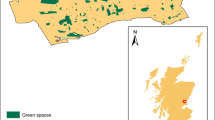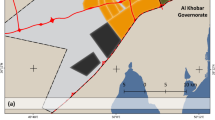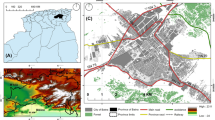Abstract
The rapid growth of urbanization and the growing need for fair and equitable distribution of urban services is one of the important issues and challenges for urban planners and managers. Eskişehir city has been experiencing rapid urbanization in recent decades. This can lead to imbalances in the distribution of public services. The purpose of this study is to determine the coverage radius and spatial distribution of some public services as well as the location-allocation of new facilities in Eskişehir city. For this purpose, data related to some services such as fire stations, emergency centers, and urban parks were collected, preprocessed, and analyzed using network analysis in the Geographic Information Systems (GIS) environment. Service area and location-allocation analyses were applied. The findings of this study showed that the majority of the city population has access to emergency health centers within a 10-min drive time. However, Eskişehir city center does not have a sufficient distribution of fire stations and urban parks in terms of service coverage. Significant parts of the city are out of the range of fire stations at optimum response time (3–4 min). The study showed that the amount of green space per person is about 8.2 m2. Green spaces in some neighborhoods were found to have been inadequately distributed in relation to population. For this purpose, using GIS-based location-allocation network analysis, some suggestions have been presented to fill the service area gaps and solve the distribution problem by using the appropriate algorithm. The research provides valuable insights for urban managers and planners, emphasizing the need for accurate and effective management of urban areas using GIS technology.













Similar content being viewed by others
Data availability
All data and models generated or used during the study are available from the corresponding author upon reasonable request.
References
Abd El Karim, A., & Awawdeh, M. M. (2020). Integrating GIS accessibility and location-allocation models with multicriteria decision analysis for evaluating quality of life in Buraidah City. KSA. Sustainability, 12(4), 1412.
Aktaş, E., Özaydın, Ö., Bozkaya, B., Ülengin, F., & Önsel, Ş. (2013). Optimizing fire station locations for the Istanbul metropolitan municipality. Interfaces, 43(3), 240–255.
Algharib, S. M. (2011). Distance and coverage: An assessment of location-allocation models for fire stations in Kuwait City. Kent State University.
Aysun, T. (2015). Effects of urban parks on urban ecology: A case study on the city of Eskişehir. Düzce Üniversitesi Bilim Ve Teknoloji Dergisi, 3(2), 535–543.
Baloyi, E., Mokgalaka, H., Green, C., & Mans, G. (2017). Evaluating public ambulance service levels by applying a GIS based accessibility analysis approach. South African Journal of Geomatics, 6(2), 172–183.
Bentivegna, V., Curwell, S., Deakin, M., Lombardi, P., Mitchell, G., & Nijkamp, P. (2002). A vision and methodology for integrated sustainable urban development: BEQUEST. Building Research & Information, 30(2), 83–94.
Bolouri, S., Vafaeinejad, A., Alesheikh, A. A., & Aghamohammadi, H. (2018). The ordered capacitated multi-objective location-allocation problem for fire stations using spatial optimization. ISPRS International Journal of Geo-Information, 7(2), 44.
Boyne, G., Powell, M., & Ashworth, R. (2001). Spatial equity and public services: An empirical analysis of local government finance in England. Public Management Review, 3(1), 19–34.
Bürger, A., Wnent, J., Bohn, A., Jantzen, T., Brenner, S., Lefering, R., Seewald, S., Gräsner, J.-T., & Fischer, M. (2018). The effect of ambulance response time on survival following out-of-hospital cardiac arrest. Deutsches Ärzteblatt International, 115(33–34), 541–548. https://doi.org/10.3238/arztebl.2018.0541
Comber, A., Brunsdon, C., & Green, E. (2008). Using a GIS-based network analysis to determine urban greenspace accessibility for different ethnic and religious groups. Landscape and Urban Planning, 86(1), 103–114. https://doi.org/10.1016/j.landurbplan.2008.01.002
Comber, A., Brunsdon, C., Hardy, J., & Radburn, R. (2009). Using a GIS—based network analysis and optimisation routines to evaluate service provision: A case study of the UK post office. Applied Spatial Analysis and Policy, 2(1), 47–64.
Curtin, K. M. (2018). 1.12—Network Analysis. In B. Huang (Ed.), Comprehensive geographic information systems (pp. 153–161). Elsevier. https://doi.org/10.1016/B978-0-12-409548-9.09599-3
Davoodi, M., & Mesgari, M. S. (2018). A GIS based fire station site selection using network analysis and set covering location problem (case study: Tehran, Iran). In The 2NDInternational Conference on Sustainability, Human Geography and Environment, December2018.
Deliry, S. I., & Uyguçgil, H. (2020). GIS-based land suitability analysis for sustainable urban development: A case study in Eskişehir, Turkey. Afyon Kocatepe Üniversitesi Fen Ve Mühendislik Bilimleri Dergisi, 20(4), 634–650.
Do, Y. K., Foo, K., Ng, Y. Y., & Ong, M. E. H. (2013). A quantile regression analysis of ambulance response time. Prehospital Emergency Care, 17(2), 170–176.
Efiong, J. (2019). GIS-based network analysis for optimisation of public facilities closure: A study on libraries in Leicestershire, United Kingdom. Journal of Geography, Environment and Earth Science International, 23(3), 1–18.
ESRI. (2021). Environmental Systems Research Institute. https://www.esri.com
Forkuo, E. K., & Quaye-Ballard, J. A. (2013). GIS based fire emergency response system.
Gray, R. (2002). The social accounting project and accounting organizations and society privileging engagement, imaginings, new accountings and pragmatism over critique? Accounting, Organizations and Society, 27(7), 687–708.
Harvey, D. (2010). Social justice and the city (Vol. 1). University of Georgia press.
Kaczynski, A. T., Potwarka, L. R., & Saelens, B. E. (2008). Association of park size, distance, and features with physical activity in neighborhood parks. American Journal of Public Health, 98(8), 1451–1456.
Kuta, A. A., Odumosu, J. O., Ajayi, O. G., Zitta, N., Samail-Ija, H. A., & Adesina, E. A. (2014). Using a GIS-based network analysis to determine urban greenspace accessibility for different socio-economic groups, specifically related to deprivation in Leicester UK. Civil and Environmental Research, 6(9), 12–20.
La Rosa, D. (2014). Accessibility to greenspaces: GIS based indicators for sustainable planning in a dense urban context. Ecological Indicators, 42, 122–134. https://doi.org/10.1016/j.ecolind.2013.11.011
Mell, H. K., Mumma, S. N., Hiestand, B., Carr, B. G., Holland, T., & Stopyra, J. (2017). Emergency medical services response times in rural, suburban, and urban areas. JAMA Surgery, 152(10), 983–984. https://doi.org/10.1001/jamasurg.2017.2230
Mitchell, D. (2003). The right to the city: Social justice and the fight for public space. Guilford press.
Mohammadi, A., Tavakoli Naghmeh, M., Abbasi, S., & Talkhab, A. (2017). Spatial analysis of urban services using network analyzer in the GIS environment (case study: Babolsar City). Journal of Urban Social Geography, 4(1), 111–130.
Neutens, T., Delafontaine, M., Scott, D. M., & De Maeyer, P. (2012). A GIS-based method to identify spatiotemporal gaps in public service delivery. Applied Geography, 32(2), 253–264. https://doi.org/10.1016/j.apgeog.2011.05.006
Nguyen, T. T., Verdoodt, A., Van, Y. T., Delbecque, N., Tran, T. C., & van Ranst, E. (2015). Design of a GIS and multi-criteria based land evaluation procedure for sustainable land-use planning at the regional level. Agriculture, Ecosystems & Environment, 200, 1–11. https://doi.org/10.1016/j.agee.2014.10.015
Oh, J.-Y., Hessami, A., & Yang, H. J. (2019). Minimizing response time with optimal fire station allocation. Stud Eng Technol, 6(1), 47–58.
Oh, K., & Jeong, S. (2007). Assessing the spatial distribution of urban parks using GIS. Landscape and Urban Planning, 82(1), 25–32. https://doi.org/10.1016/j.landurbplan.2007.01.014
Oppong, J. R., Boakye, K., Edziyie, R., Owusu, A. Y., & Tiwari, C. (2017). Emergency fire response in Ghana: The case of fire stations in Kumasi. African Geographical Review, 36(3), 253–261.
Parvin, F., Ali, S. A., Hashmi, S., & Khatoon, A. (2021). Accessibility and site suitability for healthcare services using GIS-based hybrid decision-making approach: A study in Murshidabad India. Spatial Information Research, 29(1), 1–18.
Peleg, K., & Pliskin, J. S. (2004). A geographic information system simulation model of EMS: Reducing ambulance response time. The American Journal of Emergency Medicine, 22(3), 164–170. https://doi.org/10.1016/j.ajem.2004.02.003
Russo, A., & Cirella, G. T. (2018). Modern compact cities: How much greenery do we need? International Journal of Environmental Research and Public Health, 15(10), 2180. https://doi.org/10.3390/ijerph15102180
Scholten, H. J., & Stillwell, J. (2013). Geographical information systems for urban and regional planning (Vol. 17). Springer Science & Business Media.
Şen, A., Önden, İ., Gökgöz, T., & Şen, C. (2011). A GIS approach to fire station location selection. GeoInformation for Disaster Management.
Serag El Din, H., Shalaby, A., Farouh, H. E., & Elariane, S. A. (2013). Principles of urban quality of life for a neighborhood. HBRC Journal, 9(1), 86–92. https://doi.org/10.1016/j.hbrcj.2013.02.007
Shahparvari, S., Fadaki, M., & Chhetri, P. (2020). Spatial accessibility of fire stations for enhancing operational response in Melbourne. Fire Safety Journal, 117, 103149. https://doi.org/10.1016/j.firesaf.2020.103149
Tansley, G., Schuurman, N., Amram, O., & Yanchar, N. (2015). Spatial access to emergency services in low-and middle-income countries: A GIS-based analysis. PLoS ONE, 10(11), e0141113.
Uddin, M. S., & Warnitchai, P. (2020). Decision support for infrastructure planning: A comprehensive location–allocation model for fire station in complex urban system. Natural Hazards, 102(3), 1475–1496.
Unal, M., Uslu, C., & Cilek, A. (2016). GIS-based accessibility analysis for neighbourhood parks: The case of Cukurova district. Journal of Digital Landscape Architecture, 1, 46–56. https://gispoint.de/fileadmin/user_upload/paper_gis_open/DLA_2016/537612006.pdf
Wang, S., Wang, M., & Liu, Y. (2021). Access to urban parks: Comparing spatial accessibility measures using three GIS-based approaches. Computers, Environment and Urban Systems, 90, 101713. https://doi.org/10.1016/j.compenvurbsys.2021.101713
Wheeler, S. M., & Beatley, T. (2014). Sustainable urban development reader. Routledge.
WHO, W. H. (2012). Health indicators of sustainable cities in the context of the Rio+ 20 UN conference on sustainable development. WHO Geneva, Switzerland
Funding
The authors have no relevant financial or non-financial interests to disclose. No funding was received for conducting this study.
Author information
Authors and Affiliations
Corresponding author
Ethics declarations
Conflict of interest
The authors declare that they have no conflict of interest associated with this publication.
Ethical approval
We have no conflicts of interest associated with this publication, and there has been no financial support for this work to disclose. As the corresponding author, I confirm that the manuscript has been read and approved by all the named authors for submission to the journal.
Consent to participate
Not applicable.
Consent to publish
Not applicable.
Additional information
Publisher's Note
Springer Nature remains neutral with regard to jurisdictional claims in published maps and institutional affiliations.
Rights and permissions
Springer Nature or its licensor (e.g. a society or other partner) holds exclusive rights to this article under a publishing agreement with the author(s) or other rightsholder(s); author self-archiving of the accepted manuscript version of this article is solely governed by the terms of such publishing agreement and applicable law.
About this article
Cite this article
Deliry, S.I., Uyguçgil, H. Accessibility assessment of urban public services using GIS-based network analysis: a case study in Eskişehir, Türkiye. GeoJournal 88, 4805–4825 (2023). https://doi.org/10.1007/s10708-023-10900-y
Accepted:
Published:
Issue Date:
DOI: https://doi.org/10.1007/s10708-023-10900-y




